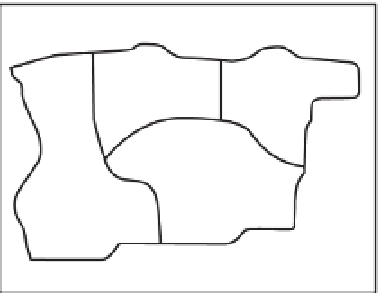Geography Reference
In-Depth Information
Areas
A GIS needs to be able to store information about areas, as well as points and lines. For example,
such areas might be ownership parcels. Each parcel would be delineated by the lines determined by a
land surveyor. Those lines define an area. A record would exist in the relational database that would
correspond to the area. The attributes in the record might be owner's name, tax identification number,
area of the parcel, and perimeter of the parcel. See Figure 1-15.
Did I mention?
A GIS is the marriage of a (geo)graphical database and an attribute database.
Polygons
FIGURE 1-15 Marriage of a polygon geographic database and a relational database table
Computer Software: In General
Computers, considered at the most fundamental level, do only three things:
26
get input, manipulate data,
and produce output; that is, read bits, stir bits, and write bits. What tells the computer what to do? In the
early days of computers, more than half a century ago, each individual instruction to a computer came
from outside, one at a time. This process was soon automated so that external media, such as perforated
paper tape or magnetic tape, contained the instructions. Then, several scientists
27
got the idea of placing
the instructions in the store of the computer itself. This major breakthrough in computer development
allowed the computer to execute one group of instructions and then, on the basis of testing bits in its
memory (e.g., Is number “a” larger than number “b”?), execute another group of instruction in a different
place in that memory. This let the computer simulate “reasoning” and “decision making.” This concept of
a
stored program
revolutionized computer use.
The modern computer may hold an immense number of data sets and store a large number of programs.
If a given program or data set not being used usually resides in “slow” disk (usually electromechanical)
memory. Dealing with large numbers of diverse elements requires a management scheme. With
computers this takes the form of an
operating system
that allows the user to execute specific programs
26
Fundamentals that we'll discuss further in Chapter 6.
27
John von Neumann, J. Presper Eckert, John Mauchly, Authur Burks, Maurice Wilkes, and others.












Search WWH ::

Custom Search